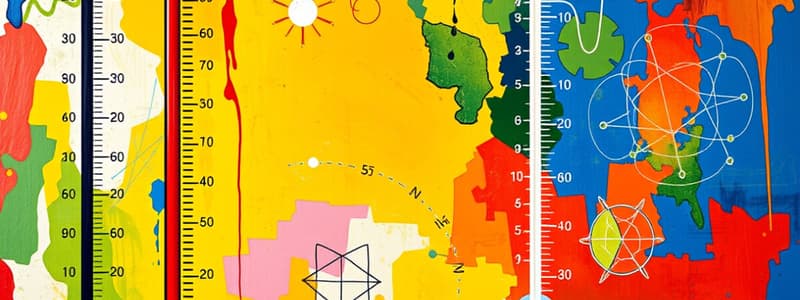Podcast
Questions and Answers
Which of the following systems is NOT a metric system?
Which of the following systems is NOT a metric system?
- MKS system
- Imperial system (correct)
- MTS system
- CGS system
The Fahrenheit scale was developed by Anders Celsius.
The Fahrenheit scale was developed by Anders Celsius.
False (B)
The unit of power defined as rotating a mill wheel of 12 m 144 times per hour is known as __________.
The unit of power defined as rotating a mill wheel of 12 m 144 times per hour is known as __________.
horsepower
What is the boiling point of water on the Fahrenheit scale?
What is the boiling point of water on the Fahrenheit scale?
Match the following SI base units with their corresponding quantities:
Match the following SI base units with their corresponding quantities:
What is the value of the speed of light in metres per second?
What is the value of the speed of light in metres per second?
The 2019 redefinition of the SI base units has no impact on the definitions of base units.
The 2019 redefinition of the SI base units has no impact on the definitions of base units.
What is the defining constant for the kilogram?
What is the defining constant for the kilogram?
How many base units are there in the International System of Units (SI)?
How many base units are there in the International System of Units (SI)?
Study Notes
Units
- Basis for calculations and measurements.
- Metric system established in France in 1795; includes CGS, MTS, MKS, and MMGS systems.
- English units originated before 1824, evolving into Imperial units post-1824.
- The United States customary system was formalized in 1832.
- International System of Units (SI units) adopted in 1960; includes 7 base units and derived units.
Basis of Units – Temperature
- Fahrenheit scale introduced by Daniel Gabriel Fahrenheit in 1724.
- Key points:
- 212 °F - Boiling point of water
- 32 °F - Freezing point of water
- 96 °F (or 98.6 °F) - Human body temperature
- Key points:
- Celsius scale developed by Anders Celsius in 1742.
- Absolute temperature scale formulated by Lord Kelvin in 1848.
Basis of Units – Power
- Horsepower, defined by James Watt in 1782, measures mechanical power.
- Equivalent to rotating a mill wheel of 12 ft, 144 times/hr using force of 180 lbs.
- Calculated power: 1 horsepower ≈ 736 Watts.
- Watt, introduced in 1882, is defined as:
- 1 W = 1 J/s = 1 N·m/s = 1 V·A.
SI Units – Base Units
- Time (T): second (s) represented by transition frequency of 9192631770 Hz.
- Length (L): metre (m) defined by the speed of light (299,792,458 m/s).
- Mass (M): kilogram (kg) based on the Planck constant (6.62607015×10⁻³⁴ J·s).
- Electric current (I): ampere (A) defined by elementary charge (1.602176634×10⁻¹⁹ C).
- Thermodynamic Temperature (Θ): kelvin (K) linked to Boltzmann constant (1.380649×10⁻²³ J/K).
- Amount of Substance (N): mole (mol) related to Avogadro's number (6.02214076×10²³ mol⁻¹).
- Luminous Intensity (J): candela (cd) based on luminous efficacy (683 lm/W at 540 THz).
Redefinition of SI Base Units (2019)
- Significant changes made to the definitions of SI base units to improve precision and consistency.
Dimensions
- Dimensions generalize a physical quantity, making them independent of the unit being used.
- Specific quantities like density have their corresponding dimensions clearly defined.
Studying That Suits You
Use AI to generate personalized quizzes and flashcards to suit your learning preferences.
Description
Explore the fundamentals of measurement units in this quiz, covering both metric and English systems, as well as temperature scales. Test your knowledge on the history and significance of various units like Fahrenheit, Celsius, and horsepower. Perfect for students studying mathematics or science-related subjects.



